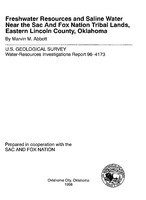The purpose of this project was to evaluate the freshwater resources and possible sources of high-chloride and high-sulfate concentrations in parts of the aquifer near the Sac and Fox Nation tribal land in eastern Lincoln County, Oklahoma. Water-quality sampling and borehole geophysical data indicate the potential for fresh ground water on tribal land generally is greatest in the Vanoss Formation, in the SE1/4 sec. 21, T. 14 N., R. 06 E. and in the NE1/4 sec. 22, T. 14 N., R. 06 E. These locations avoid the flood-prone areas and borehole geophysical resistivity logs indicate the altitude of the base of fresh ground water is below 650 ft. The altitude of the base of fresh ground water is indicated to be generally near the surface under the W1/2 sec. 22, T. 14 N., R. 06 E., the SE1/4 sec. 22, SE1/4 SE1/4 NE1/4 sec. 21, and NE1/4 NW1/4 NW1/4 sec. 27.
Conditions are more favorable for placement of fresh ground-water wells in sec. 34, T. 14 N., R. 06 E., where the tribe has leased water rights, than on tribal land in secs. 15, 16, 21, and 22, T. 14 N., R. 06 E. Sandstones overlain by or enclosed in thick clay and shale sequences are likely to be somewhat isolated from the flow system and retain some of the residual brine. Borehole geophysical logs suggest that sandstones near CH1, CM1, and WT1 have more clay and shale content than the sandstones near L2. Greater amounts of clay in the sandstones will retard the flushing of residual brines from the sandstones and could result in a shallow base of fresh water near CH1, CM1, and WT1. For these reasons and because circulation of fresh ground water is limited by discharge to the Deep Fork, general water quality under tribal land would probably be poorer than in the area where the tribe has leased water rights.
Samples have chloride or sulfate concentrations greater than 250 milligrams per liter in the W1/2 sec. 22, T. 14 N., R. 06 E. Six cluster well samples from tribal land have chloride or sulfate concentrations above the suggested maximum contaminant levels set by U.S. Environmental Protection Agency.
Water-quality data indicate there may be more than one source for the salinity in the very saline and briny samples near the tribal land. Two possible sources for chloride and sulfate in water-quality samples are shallow brines and deep oil brines. Probable sources of shallow brines in the study area are: 1) solution of minerals by fresh water moving through the aquifer and 2) residual brines deposited with the sediment. There are no salt or gypsum beds in the Vanoss, Ada, or Vamoosa Formations, but there may be nodules and finely disseminated minerals present in the formations. Residual brines could remain in sand stones and shales that have low hydraulic conductivity and have not been diluted by freshwater recharge. Data suggest both sources have mixed with the fresh ground water from the Vanoss Formation. This is indicated by the relations of the bromide/chloride concentration ratio to chloride concentration, delta deuterium to delta 18oxygen, and by delta 18oxygen to chloride molality relation.


